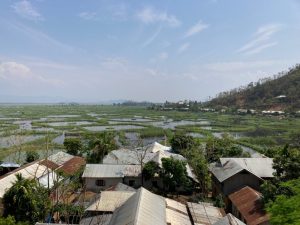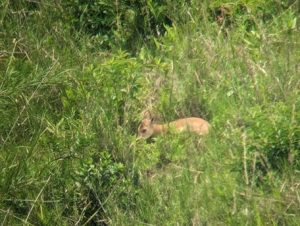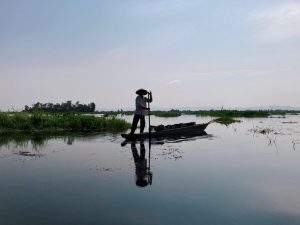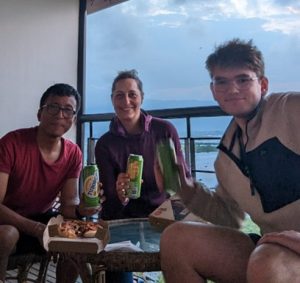July 27, 2023, by lzzre
‘Core Blimey!’– A PhD fieldwork trip to India
Hamish Duncalf-Youngson, PhD student
Arriving in Manipur jolts your senses to life, from the heat and dust to the chaotic driving practices (which heavily require dodging cows in the middle of four-lane roads). None of this should have surprised me, perhaps, given I’d just arrived in India for the first time. Yet, I soon learnt that Manipur is a place completely unique and wonderful in its own right. The state sits as one of the seven Northeast Indian ‘sister states’ nestled between Bangladesh and Myanmar. It would be the site of my fieldwork for the next two weeks.
On our first day in Manipur, my supervisors (Dr Rajiv Kangabam and Dr. Virginia Panizzo) and I organised a local stakeholder meeting that took place on the shore of Loktak Lake – the reason we’d come here. Lake Loktak is the largest lake in Northeast India and one of the largest in all of Southern Asia. It is a place of enormous beauty and is critically important to the local culture and traditions. The latter is made abundantly clear by the circular phumdi scattered across the lake and the fisherman meticulously tending to the nets surrounding them. The phumdi are a bizarre phenomenon which take the form of floating islands, comprised of vegetation and organic matter. They have been utilised by local people for centuries, being used in traditional fishing practices and even have small villages built upon them.
The stakeholder meeting provided an opportunity for local people to voice their concerns regarding the lake and for us to explain the research we would be undertaking, with the event even managing to gain publicity with the local media. One local person explained to us that a meal in Manipur is not considered complete without fish, highlighting the importance of the lake to the people here.
The lake is not only the lifeblood for the Manipuri people, providing food, drinking water and livelihoods, but also for a diverse range of flora and fauna. Over 57 species of waterbird depend upon the lake, alongside a number of rare animals including the Indian python and several species of endangered deer. None are as symbolic of the plight of Lake Loktak as the Sangai deer, whose fate is deeply entwined with that of the lake. There remain only 260 individuals of this species globally, all of which live in the Keibul Lamjao national park at the southern part of the Loktak Wetland. The future of this species (and many others that call Lake Loktak home) lie in a precarious position. The main threat to their existence is the rapid deterioration in the lake’s health, largely due to increased human activity. Pressures that have already caused harm to the system continue to be instrumental in its present-day degradation. These pressures include pollution from upstream urban settlements such as Imphal (the state capital, with a population of over 200,000), fertiliser/pesticides from agriculture, increases in fishing (and pesticide use in fishing practices) and the construction of the Ithai Dam.
When speaking to the locals at the stakeholder meeting, the dam in the particular seemed to be the source of most notable concern. It is explained to me that before the construction of the Ithai dam, the characteristic phumdi would drain on a seasonal basis. However, the dam makes this impossible, and as a result the floating islands remain in the lake system, reducing the surface area and altering the biogeochemical cycling of the lake.
The construction of the dam, alongside the other anthropogenic pressures, including climate change, have resulted in the lake experiencing a severe reduction in ecological health. Though there are sincere concerns amongst the locals, up to this point, little has been done resurrect any of the damage. Unless measures are undertaken, it is likely that the lake will continue to deteriorate. This will happen at the expense of both the already fragile flora and fauna, and the people whose lives are dependent on the lake.
Due to the India Standard Time (which remains constant for the entire country) and its relatively eastern position, people in Manipur find themselves with a sun that rises and sets very early. Something the local people have had to deal with. Yet, this is a problem that typifies the situation of the state, major legislative and infrastructure changes – such as the removal of a large dam – need to be approved by the central government in faraway New Delhi. Learning of these difficulties, I find it very easy to sympathise with the frustrations of the local people.
The fieldwork itself was an amazing immersion into the nature and culture of the lake and its surrounding area. It broadly consisted of taking sediment core and water samples, which would be analysed back in the UK. Often it would require the use of traditional dugout canoes as larger boats would either not fit down the narrow gaps between phumdi or would cut the fishing lines with their motors. Taking sediment cores from these vessels proved to be a strong test for our athleticism, though fortunately, none of us ended up in the beautiful (yet potentially pesticide filled) lake. The sediment cores will allow the reconstruction of the past ecological and geochemical conditions of the lake, whilst the contemporary water samples will enable the current health of the lake to be assessed. The techniques will involve using carbon and nitrogen stable isotopes, alongside biological indicators such as algal pigments and diatoms to evaluate the health of this vastly important wetland. Overall, this research will highlight the most pressing threats to the lake and guide conservation efforts going forward.
I sadly learnt that that only a week after our departure from Manipur, the state and in particular the capital, Imphal, underwent a period of severe civil unrest that affected everyone in some capacity, with many people killed and displaced. There have been a number of lockdowns and the internet is still banned. My thoughts are with the Manipuri people, and I very much hope that the issues can be resolved and peace can be restored in this wonderful place.
Finally, I would like to extend my sincerest gratitude to my supervisors Ginnie and Rajiv, alongside the delightful people of Manipur for making this trip possible.
No comments yet, fill out a comment to be the first







Leave a Reply